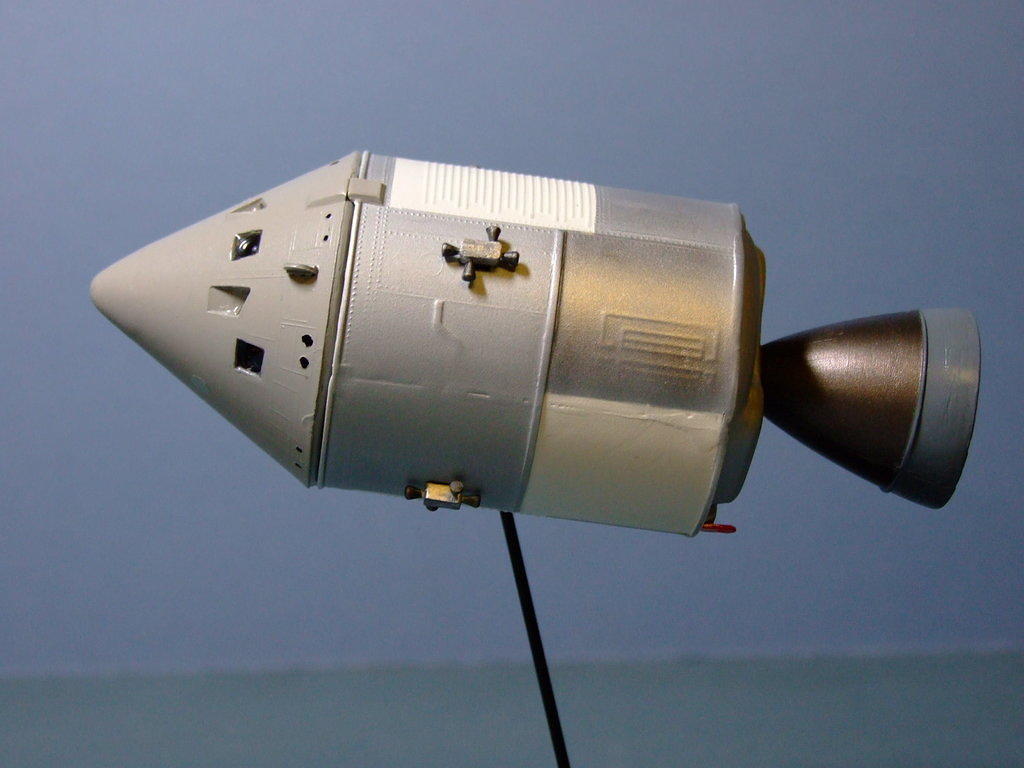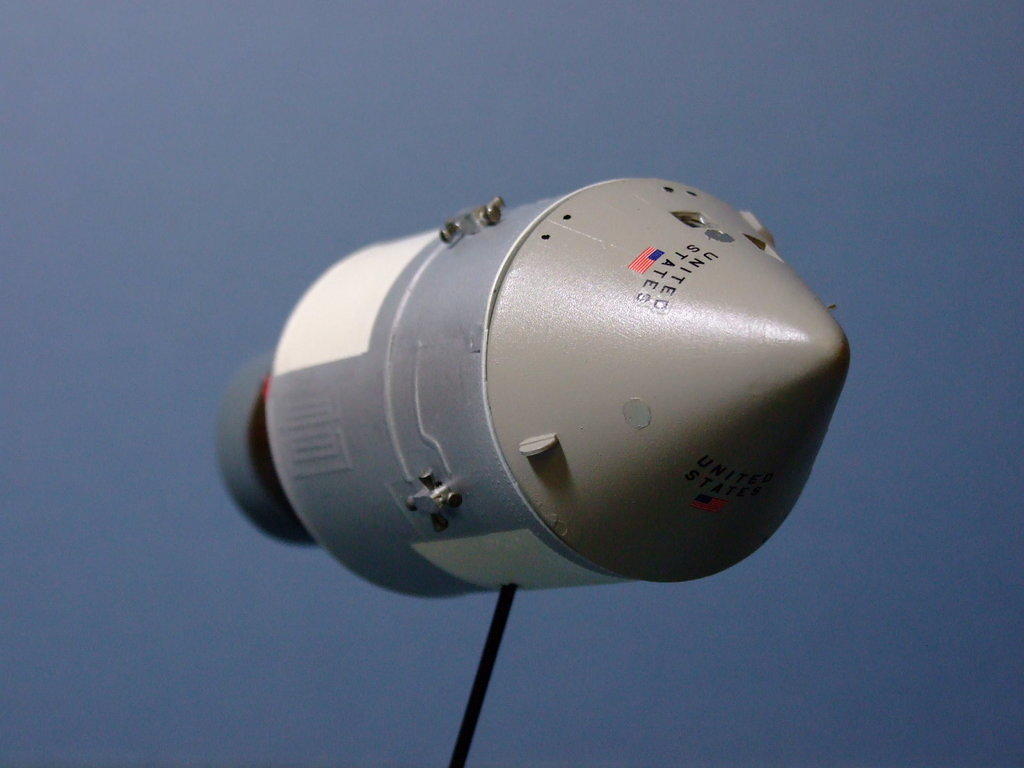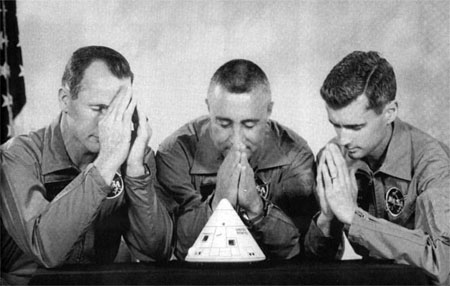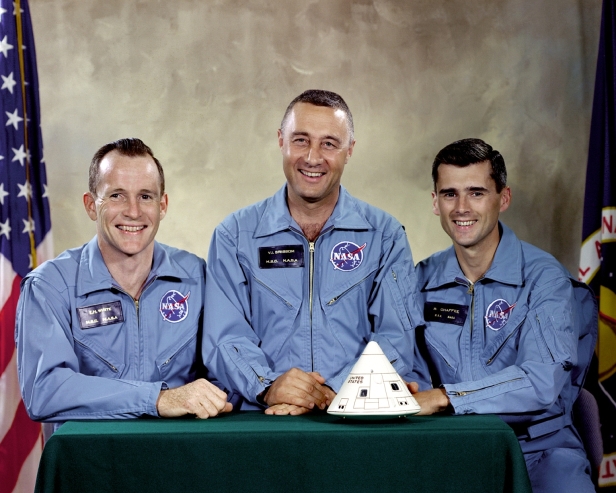Apollo 1 Fire - 50 Years Ago Today
Discussion
There is a Challenger memorial thread which i will resurrect tomorrow, I wanted to have a separate thread for the Apollo disaster because it is the 50th anniversary.
A number of years ago I built a model of a Block 1 Apollo Command and Service Module - which was significantly different to the Block 2s that were actually used for all the manned flights.
After the fire, it was decided that the Block 1s (of which a number had been built) would not be used for manned flights.


A number of years ago I built a model of a Block 1 Apollo Command and Service Module - which was significantly different to the Block 2s that were actually used for all the manned flights.
After the fire, it was decided that the Block 1s (of which a number had been built) would not be used for manned flights.
Sorry to mention Challenger. The close coincidence of the dates though.
I visited the pad when I did a Cape tour in 2004. There is a memorial plaque there for the brave three.
Arguably, if the fire hadn't happened, they would have never got to the moon two & a bit years later.
So many lessons learnt from the disaster (pure oxygen environment, dodgy wiring, velcro, inward opening crew hatch & the likes).
Gus never had any luck....
I visited the pad when I did a Cape tour in 2004. There is a memorial plaque there for the brave three.
Arguably, if the fire hadn't happened, they would have never got to the moon two & a bit years later.
So many lessons learnt from the disaster (pure oxygen environment, dodgy wiring, velcro, inward opening crew hatch & the likes).
Gus never had any luck....
Squadrone Rosso said:
Sorry to mention Challenger. The close coincidence of the dates though.
I visited the pad when I did a Cape tour in 2004. There is a memorial plaque there for the brave three.
Arguably, if the fire hadn't happened, they would have never got to the moon two & a bit years later.
So many lessons learnt from the disaster (pure oxygen environment, dodgy wiring, velcro, inward opening crew hatch & the likes).
Gus never had any luck....
There are a whole load of myths associated with the "changes" made after the fire. I visited the pad when I did a Cape tour in 2004. There is a memorial plaque there for the brave three.
Arguably, if the fire hadn't happened, they would have never got to the moon two & a bit years later.
So many lessons learnt from the disaster (pure oxygen environment, dodgy wiring, velcro, inward opening crew hatch & the likes).
Gus never had any luck....
NASA did not change the atmosphere of the Apollo system after the fire. They continued to use a pure oxygen atmosphere right to the end of Apollo - including Skylab and the Apollo-Soyuz flight of 1975. The change they made was to never again pump the atmosphere in the capsule up to 14 pounds per square inch when it was sitting on the pad. Apollo was designed to operate with a 5 PSI pure oxygen atmosphere in space - which was deemed safe enough. That did not change after the fire.
The outward opening hatch was already designed and built BEFORE the fire. It was chiefly designed so that EVAs could be performed on an Apollo mission. The original inward opening design did not allow EVAs.
However, when sitting on the pad, the Command Module was seated inside a fibreglass cone called the Boost Protect Cover. The BPC had its own hatch which sat directly over the main Command Module hatch. In the Block 1 design the two hatches needed to be opened separately. The change made to the hatch was to allow the TWO elements of the hatch to be opened in one movement speeding (they hoped) emergency egress on the pad.
Velcro continued to be used for the remainder of the Apollo missions. It was not a problem so long as the pure oxygen atmosphere was kept at 5 psi.
The other main changes were in manufacturing techniques and quality control as there had been many complaints about shoddy workmanship in the early Apollo spacecraft that were coming out of the North American assembly plant.
Also, a couple of key individuals got the old heave ho - notably Harrison Storms at North American and Joe Shea at NASA.
The Apollo Command and Service Module design was started in mid 1960. When Lunar Orbit Rendezvous was chosen as the way to go the moon, it immediately became obvious that this original design would not work. So a new updated model was instigated. From that point the original design was referred to as the Block 1 and the more advanced version the Block 2.
Apart from the differences I've already mentioned, the key difference was the fact that the Block 2 had a docking probe and tunnel to allow access to the Lunar Module. The Block 1 was not so equipped as its design had commenced before anybody had thought of a craft called a Lunar Module.
Really weird; I spent ages going through various space accidents over the weekend, Soviet and American but the dates hadn't clicked.
Re the Velcro - I'm sure I read that they changed it for a Teflon coated replacement made from fireproof material, otherwise you're spot on, as usual, re the other modifications.
Re the shonky work; I think they recovered a wrench tucked away somewhere in the cabin that had been left by accident after the build.
Re the Velcro - I'm sure I read that they changed it for a Teflon coated replacement made from fireproof material, otherwise you're spot on, as usual, re the other modifications.
Re the shonky work; I think they recovered a wrench tucked away somewhere in the cabin that had been left by accident after the build.
They did indeed. In fact, the shoddy work had been a growing problem for a couple of years. NASA had even commissioned a report a few years earlier into North American's poor quality control.
The report was kept secret and it only emerged during the Congressional hearings into the fire. A copy of the report was secretly passed on to Senator Walter Mondale (remember him?) who then produced it at the hearing, much to the embarrassment of the NASA Director James Webb who had already denied that such a report existed. It was one of NASA's worst moments.
The report was kept secret and it only emerged during the Congressional hearings into the fire. A copy of the report was secretly passed on to Senator Walter Mondale (remember him?) who then produced it at the hearing, much to the embarrassment of the NASA Director James Webb who had already denied that such a report existed. It was one of NASA's worst moments.
Oxygen is a strange beast and must be treated with the utmost of respect.
Having worked in the industrial gases business for many years, I've had to investigate quite a few Oxygen fires. Most have been down to lack of procedure, training or basic human error.
High concentrations (>99.9%), high pressure, incompatible materials, contamination (normally Hydrocarbons) or high velocities can provide the ideal atmosphere to support combustion and promote high temperature fires.
I've seen many a system given the 'green light' for Oxygen use, only to determine that the correct cleaning procedures and testing were not undertaken. I can easily imagine that NASA did not adhere to their own procedures..
Having worked in the industrial gases business for many years, I've had to investigate quite a few Oxygen fires. Most have been down to lack of procedure, training or basic human error.
High concentrations (>99.9%), high pressure, incompatible materials, contamination (normally Hydrocarbons) or high velocities can provide the ideal atmosphere to support combustion and promote high temperature fires.
I've seen many a system given the 'green light' for Oxygen use, only to determine that the correct cleaning procedures and testing were not undertaken. I can easily imagine that NASA did not adhere to their own procedures..
Max_Torque said:
What was the original reason for using the pressure equalised atmosphere during testing?
Check for leaks.They should not have done it with people on board - but they had done it through all the Mercury and Gemini missions and were comfortable with the procedures they were using. Mercury and Gemini spacecraft were built by McDonnell. The Apollo Command/Service Modules were built by North American and their standard of workmanship was deemed not to be as good as that of McDonnell's.
I always think this picture says it all -

Eric Mc said:
Max_Torque said:
What was the original reason for using the pressure equalised atmosphere during testing?
Check for leaks.They should not have done it with people on board - but they had done it through all the Mercury and Gemini missions and were comfortable with the procedures they were using. Mercury and Gemini spacecraft were built by McDonnell. The Apollo Command/Service Modules were built by North American and their standard of workmanship was deemed not to be as good as that of McDonnell's.
I always think this picture says it all -

Eric Mc said:
They should not have done it with people on board - but they had done it through all the Mercury and Gemini missions and were comfortable with the procedures they were using. Mercury and Gemini spacecraft were built by McDonnell.
This is a great example of the benefits of a rigorous FMEA process. Dull as ditchwater and a right pain in the arse, but essential to catch all the things that might go wrong, even though "we've always done it that way..."anonymous-user said:
Eric Mc said:
Max_Torque said:
What was the original reason for using the pressure equalised atmosphere during testing?
Check for leaks.They should not have done it with people on board - but they had done it through all the Mercury and Gemini missions and were comfortable with the procedures they were using. Mercury and Gemini spacecraft were built by McDonnell. The Apollo Command/Service Modules were built by North American and their standard of workmanship was deemed not to be as good as that of McDonnell's.
I always think this picture says it all -

Gassing Station | Science! | Top of Page | What's New | My Stuff





